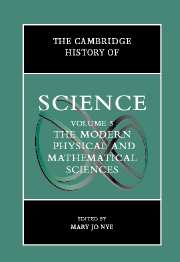Book contents
- Frontmatter
- Introduction: The Modern Physical and Mathematical Sciences
- Part I The Public Cultures of the Physical Sciences After 1800
- Part II Discipline Building in the Sciences: Places, Instruments, Communication
- Part III Chemistry and Physics: Problems Through the Early 1900s
- 11 The Physical Sciences in the Life Sciences
- 12 Chemical Atomism and Chemical Classification
- 13 The Theory of Chemical Structure and its Applications
- 14 Theories and Experiments on Radiation from Thomas Young to X Rays
- 15 Force, Energy, and Thermodynamics
- 16 Electrical Therory and Practice in the Nineteenth Century
- Part IV Atomic and Molecular Sciences in the Twentieth Century
- Part V Mathematics, Astronomy, and Cosmology Since the Eighteenth Century
- Part VI Problems and Promises at the End of the Twentieth Century
- Index
- References
15 - Force, Energy, and Thermodynamics
from Part III - Chemistry and Physics: Problems Through the Early 1900s
Published online by Cambridge University Press: 28 March 2008
- Frontmatter
- Introduction: The Modern Physical and Mathematical Sciences
- Part I The Public Cultures of the Physical Sciences After 1800
- Part II Discipline Building in the Sciences: Places, Instruments, Communication
- Part III Chemistry and Physics: Problems Through the Early 1900s
- 11 The Physical Sciences in the Life Sciences
- 12 Chemical Atomism and Chemical Classification
- 13 The Theory of Chemical Structure and its Applications
- 14 Theories and Experiments on Radiation from Thomas Young to X Rays
- 15 Force, Energy, and Thermodynamics
- 16 Electrical Therory and Practice in the Nineteenth Century
- Part IV Atomic and Molecular Sciences in the Twentieth Century
- Part V Mathematics, Astronomy, and Cosmology Since the Eighteenth Century
- Part VI Problems and Promises at the End of the Twentieth Century
- Index
- References
Summary
Surveying the history of nineteenth-century science in his magisterial A History of European Thought in the Nineteenth Century (1904–12), John Theodore Merz concluded that one “of the principal performances of the second half of the nineteenth century has been to find … the greatest of all exact generalisations – the conception of energy.” In a similar vein, Sir Joseph Larmor, heir to the Lucasian Chair of Mathematics at Cambridge once occupied by Newton, wrote in the obituary notice of Lord Kelvin (1824–1907) for the Royal Society of London in 1908 that the doctrine of energy “has not only furnished a standard of industrial values which has enabled mechanical power … to be measured with scientific precision as a commercial asset; it has also, in its other aspect of the continual dissipation of energy, created the doctrine of inorganic evolution and changed our conceptions of the material universe.” These bold claims stand at the close of a remarkable era for European physical science, which saw, in the context of British and German industrialization, the replacement of earlier Continental (notably French) action-at-a-distance force physics with the new physics of energy.
This chapter traces the construction of the distinctively nineteenth-century sciences of energy and thermodynamics. Modern historical studies of energy physics have usually taken as their starting point Thomas Kuhn’s paper on energy conservation as a case of simultaneous discovery. Kuhn’s basic claim was that twelve European men of science and engineering, working more or less in isolation from one another, “grasped for themselves essential parts of the concept of energy and its conservation” during the period between 1830 and 1850.
- Type
- Chapter
- Information
- The Cambridge History of Science , pp. 289 - 310Publisher: Cambridge University PressPrint publication year: 2002



